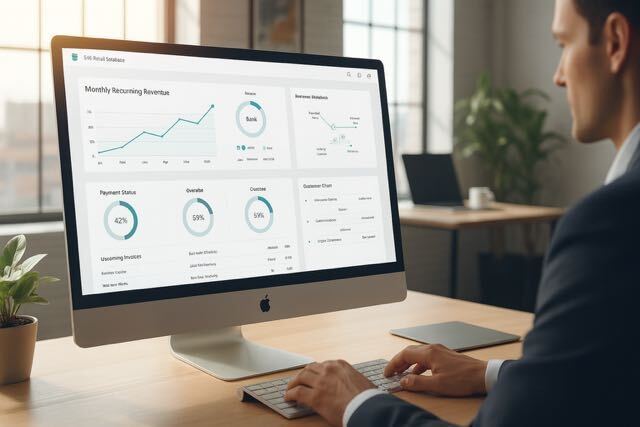How to Forecast MSP Business Revenue?

Scaling up an MSP business can feel like quite the challenge. And it’s even more challenging when you’re not sure what lies ahead for you financially.
The competition in the MSP industry is getting tougher than ever. And you need to be ready to fight whatever the future throws your way. That's where forecasting MSP business revenue comes into play.
When you have the ability to forecast your revenue, you are better equipped for planning and preparing for the future — either for scaling or for avoiing losses.
In this blog post, we'll explain why forecasting revenue is so important and how it can be your ticket to success in the MSP game.
Let’s dive right in!
What is MSP revenue forecasting?
MSP revenue forecasting is the process of figuring out how much money your MSP company will make in the future, typically over a few months or a year. It’s like having a future-telling crystal ball for your business finances.
But here's the thing: it isn’t a wild guess, this MSP revenue forecast. It's based on your past performance – how you've been doing till now – and what's happening in your business at this very moment.
So, it's like looking at your history and current situation to predict your financial future. There is no magic involved, just data and careful analysis.
Now, you might wonder, "How is it different from MSP business revenue projection?" They sound pretty similar, but they're not quite the same.
An MSP business revenue forecast helps you see where you're headed based on your current path. Revenue projection, on the other hand, takes different "what if" scenarios into account. Both are valuable numbers, but they serve slightly different purposes in planning for your MSP's financial future.
Why is MSP revenue forecasting important?
When you run an MSP, you have to ship through unpredictable waters. And to ship successfully and attain the growth you’ve always wanted, you need MSP revenue forecasting.
Let's see why MSP revenue forecasting is so important:
1. Cash flow management for stability
Smooth cash flow is the lifeblood of any business, not just MSPs. By effectively monitoring your cash inflows and outflows, revenue forecasting ensures you meet your financial obligations on time, avoiding late payments that can harm your reputation.
2. Strategic product and sales insights
Revenue forecasting isn't just about numbers; it's about understanding where your money comes from. It helps you identify which of your services are driving your profits and which might need reconsidering. This insight empowers you to make data-driven decisions about what to promote or retire.
3. Budgeting with confidence
When you forecast revenue, you're not just guessing your financial future but planning it. It allows you to set budgets and financial goals, providing a roadmap for your business. Plus, you can track your progress throughout the year to stay on course.
4. Informed decision-making
Hiring new team members or investing in resources is a big decision. Revenue forecasting equips you with the knowledge to make these decisions wisely. You'll have a clear understanding of your financial capacity, helping you determine how many new hires you can afford and what salaries you can offer.
5. Effective strategic planning
Strategic planning is a cornerstone of business success. Revenue forecasting plays a crucial role in this process, too. It not only aids in crafting effective strategies but also helps you pinpoint the right time to implement them for maximum impact.
6. Attracting investor interest
Investors love data-backed decisions. A well-prepared revenue forecast backed by market trends can significantly enhance your appeal to potential investors. It shows them how serious you are about your business and have a clear growth plan.
8. Enhanced client relationships
Understanding your customers' behavior and sales pattern is a goldmine of information. Revenue forecasting helps you identify these patterns, enabling you to plan new products and effective advertising campaigns. This keeps your customers satisfied and coming back for more.
How can you forecast MSP revenue?
Forecasting your MSP's revenue is not about making educated guesses; it's about following a systematic process to predict your financial future.
Let's see the steps for MSPs to create a reliable revenue forecast:
1. Set your timeline
Start by deciding the timeline for your revenue forecast. While the standard timeframe is usually 12 months, you may also want to extend your forecast to provide an annual prediction for the next few years.
It's essential to remember that the further out your forecast goes, the more uncertain it becomes. So, for the sake of accuracy and practicality, focus on the immediate year ahead.
2. Consider growth drivers and barriers
Before you start making predictions about your MSP's revenue, look closely at the external factors that could significantly influence your sales in the upcoming year.
These factors can be:
- Seasonal Upticks: Assess whether your MSP experiences increased or decreased business during certain seasons or months.
- Major Industry Events: Consider industry-specific events or conferences that might increase demand for your services.
- Regulatory Changes: Stay informed about upcoming legal or regulatory changes that could impact your sales, such as new compliance requirements.
- Business Activities: Think about your planned business activities, such as expansion efforts, marketing campaigns, or the launch of new services. Predict how these initiatives might affect your sales.
Drawing insights from real-life examples within your MSP industry can provide valuable context. For instance, an MSP might notice a spike in demand for web development or migration at the beginning of a year as most businesses launch updates or new campaigns. The numbers may slow down, moving towards other services like maintenance as the year progresses.
3. Estimate your expenses
Accurate revenue forecasting also depends on estimating your future expenses. While forecasting, you must take into account fixed costs (e.g., office rent, utilities, employee salaries) and variable costs (e.g., labor, software licenses).
Variable costs can fluctuate based on your sales volume, so think about how the factors you identified earlier might impact your expenses. For instance, if you plan to hire more staff to accommodate increased business, this will affect your labor costs.
4. Forecast sales
Sales are one of the most significant contributors to MSP revenue. And to forecast it, you must follow a structured approach.
Here’s what you should do for MSP sales forecasting:
- Determine total market size: Identify the total number of potential customers in your target market. Let's say you have 200,000 target customers. That means: 200,000 (number of target users) x 4 (purchases expected over 12 months) = 8,00,000 a year. This means your market volume is 8,00,0000 a year.
- Calculate market penetration: Calculate your current market share by dividing your existing sales by the total market size. For this, you will need to take the current sales volume of the service and divide it by the total sales volume of all similar services, including those sold by competitors.
- Assess customer purchasing capacity: Calculate the maximum value of purchases a customer can make from your MSP services in a year. This might require taking into account their business revenue, profits, existing resource spends and benchmarking it with past sales data to identify your average ticket size.
- Compare to average customer purchase value: Evaluate how the average customer's annual purchase value compares to the maximum potential value. To find the average purchase value, divide your business's total revenue during a time period by the number of purchases.
- Analyze competitor sales: Look at your competitors' sales trends and growth rates to adjust your sales potential accordingly. For instance, if you see your competitors gaining market share, you might need to refine your projections.
While top-down analysis provides a high-level view of your market's potential and seeks to identify the bigger picture of your MSP success, a bottom-up approach is based on more actuals. The latter gives you a realistic perspective based on your past data, market trends and competitor analysis.
5. Combine expenses and sales
Once you've assessed the factors that could increase revenue of MSP — sales and expenses, bring everything together.
Use the formula:
Number of customers x average sale value x number of units = Projected sales
Subtract your projected expenses from projected sales to calculate projected net revenue.
It’s best to start with historical data as a foundation and extend your current sales and expenses into the future. We recommend taking the smallest of expenses into account, including licenses, operational costs, human resource and others. Incorporate the planned and predicted factors and their expected effects on revenue and expenses.
For example, an MSP that experienced remarkable growth during the COVID-19 pandemic due to increased demand for remote work solutions would factor in these trends when forecasting future revenue.
6. Check with key financial ratios
Assess the realism of your forecast by examining key financial ratios:
- Gross margin: Calculate the ratio of total direct costs to total revenue (higher margins indicate better cash flow).
- Operating profit margin: Determine the profit remaining after deducting total operating expenses from revenue. This margin should improve with the increase in revenue of MSP.
7. Test different scenarios
Finally, stress-test your revenue forecast by adjusting variables within your expenses and sales projections to reflect various scenarios. In this process, you should see how changes in your business operations affect your revenue and expenses.
For example:
What would happen to your revenue forecast if you increased MSP sales calls by a certain percentage?
How would adopting new technology impact your costs (e.g., labor, technology expenses) and revenues (e.g., additional sales)?
These scenario tests provide valuable insights into the factors that can have the most significant positive or negative impact on your revenue. When you have these insights, you can proactively plan for potential challenges and opportunities, ensuring your MSP is well-prepared for whatever the future holds for you.
How does Zomentum help in MSP revenue forecasting?
MSP revenue forecasting can appear to be a huge jigsaw puzzle. But Zomentum provides the missing pieces that make it all fit together seamlessly.
Zomentum offers powerful insights and all the revenue metrics for MSPs that streamline the revenue forecasting process for MSPs.
Here's how Zomentum helps you gain complete visibility and make revenue forecasting a breeze:
1. Complete visibility: Zomentum provides MSPs with an all-around view of their operations. It allows you to effortlessly track ongoing MSP contracts, project statuses, and sales pipelines. This visibility is a crucial first step in making accurate revenue predictions.
2. Pipeline insights: With Zomentum, you get an understanding of what's in your sales pipeline, which helps you manage leads and sales proposals, enabling you to gauge conversion likelihood and the potential revenue associated with each opportunity.
3. Ticket size analytics: Accurate revenue forecasting requires knowledge of ticket sizes. Zomentum offers insights into the sizes of service requests associated with each client or project. This information helps prioritize efforts and allocate resources more efficiently.
4. Billing and invoice monitoring: Keeping tabs on billing and invoice statuses is essential for financial forecasting. Zomentum ensures you stay updated with financial transactions, making it easier to project revenue streams accurately.
Long story short, Zomentum simplifies MSP revenue forecasting by providing complete visibility of everything you need to forecast MSP revenue.
How can MSPs secure their revenue forecast and build recurring revenue?
As an MSP, you majorly serve the IT industry, where revenue often arrives in sporadic, large doses. However, the industry is evolving, with a growing trend toward MSP recurring revenue models.
While this shift can initially feel small compared to the traditional cash flow, it offers substantial benefits, particularly for revenue forecasting.
MSP recurring revenue forms a stable and predictable income source, making it an essential component of revenue forecasting. Unlike one-off projects, it offers a consistent income stream, making it easier to project future earnings more accurately. This predictability allows MSPs to plan their budgets, allocate resources efficiently, and make informed business decisions.
Moreover, customers increasingly seek outcomes and results rather than the ownership and management of individual IT components. MSPs can adapt by offering services on a pay-as-you-go basis. This approach emphasizes delivering specific business capabilities while sparing customers the complexity of dealing with underlying technical intricacies, aligning perfectly with the as-a-service model.
As an MSP, you should also ensure that your pricing is centered around the value delivered to customers rather than traditional markups. This approach involves transparently mentioning equipment and labor costs in the service without itemizing them for the customer. The focus shifts to delivering maximum value to the customer while managing costs efficiently, ensuring profitability.
Building MSP recurring revenue ensures that you have a consistent revenue stream and also enhances forecasting precision because you know a fixed number of clients are going to pay a fixed amount for a fixed time.
Accurate MSP revenue forecasting with Zomentum
The dynamic nature of today's markets, with shifting trends and emerging technologies, demands that MSPs be prepared for what lies ahead. And accurate revenue forecasting is what provides a clear path to MSPs for navigating the uncertainties.
You need a partner that empowers you with the insights necessary for effective revenue forecasting. This is where Zomentum steps in as a game-changer.
Zomentum’s MSP revenue stack provides complete visibility into ongoing contracts, pipeline management, ticket size analytics, and efficient billing and invoice monitoring. Zomentum ensures that MSPs have all they need to forecast the revenue.
Take charge of your MSP's future with Zomentum by your side. Book a demo today!





.png)









